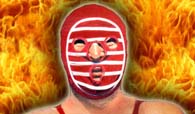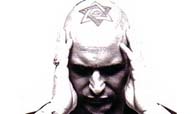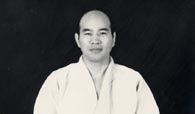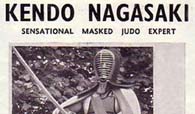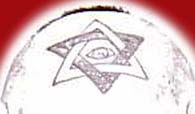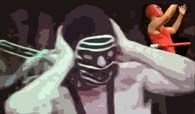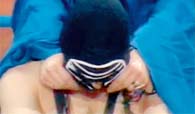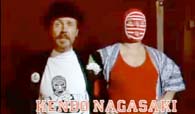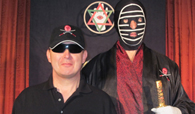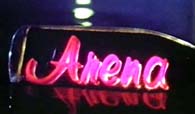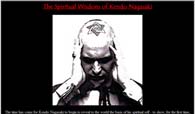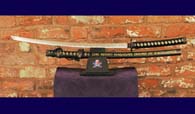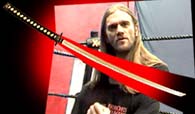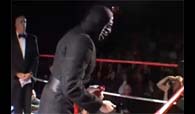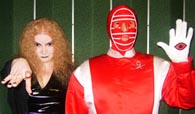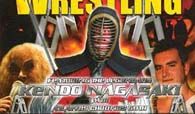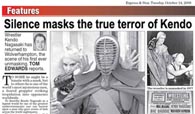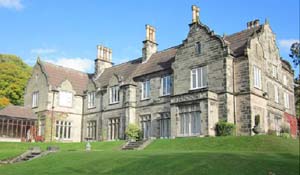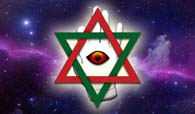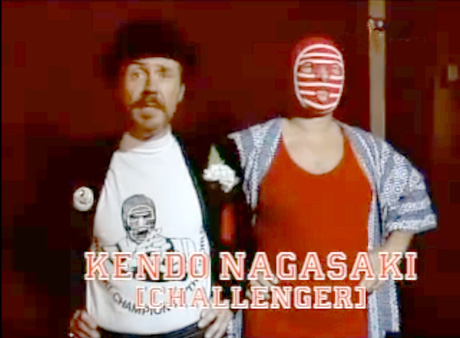
The early eighties involved less wrestling and more spirituality...
...for Kendo Nagasaki, as he increasingly sought to set down his spiritual and training regimes. It was also
reported that as a businessman totally unconnected with the Nagasaki wrestling persona, Yogensha had built up a
formidable empire in the Midlands, but this story was typical of most things surrounding Kendo - the answers are
shrouded in whispers, secrecy and rumour.
Kendo surfaced for a few brief appearances in promotions run
by Brian Dixon in 1981-82, returning to the ring with his mask once again hiding the striking features and George
as ever on hand to do the talking for him. At this time another wrestler was doing the rounds calling himself King
Kendo, dressing and wrestling in the same style, this imposter also sported the famous striped mask and George,
sensing the public were being fooled into thinking this dopelganger was the real Nagasaki, took to the ring to
challenge King Kendo to a match with the original Kendo Nagasaki. King Kendo accepted and there were a number of
heated battles as Kendo wasted little time in showing his namesake the error of his ways, and unusually Kendo took
great delight in unmasking this new rival, a role reversal from his own days trying to avoid having his identity
revealed.
After this brief stint nothing further was heard of Kendo until, quite unexpectedly George,
issued a statement late in 1986 declaring that his charge would be back in action for a special ITV charity "ladder
match", kicking off a new season of television wrestling. Max Crabtree had lost his foothold on televised
wrestling, his brother Shirley alias Big Daddy was fast losing his appeal, and ITV - wanting some fresh blood on
television - asked Brian Dixon to put together bills to complement those of the Crabtree brothers. 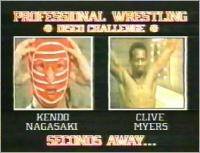 An agreement was struck to present Kendo as top of the
bill on his inaugural recording for the famed wrestling slot; with Kent Walton at ringside, the event was set at
the London Hippodrome, usually a nightclub and owned by Peter Stringfellow, for the big time return of the Samurai
legend.
An agreement was struck to present Kendo as top of the
bill on his inaugural recording for the famed wrestling slot; with Kent Walton at ringside, the event was set at
the London Hippodrome, usually a nightclub and owned by Peter Stringfellow, for the big time return of the Samurai
legend.
With the likes of Chic Cullen and Mark Rocco also on the bill it was indeed a return to form for
wrestling, such lightening speed and technical ability had not been witnessed for years. Then came the moment
everybody had been waiting for: the ladder match. Ironfist Clive Myers made his way to the ring, then out came the
sensational Kendo Nagasaki. Dressed as ever in the full ceremonial regalia, he was accompanied not only by George
(in uncharacteristic low key bowler hat and sporting a natty gentleman's umbrella) but also by Mr. Lawrence,
Kendo's personal assistant who would now accompany him to all the venues acting as driver and confidante. Never one
to moderate his views, George was quick to tell the audience and viewers at home that Kendo was back and a victory
was assured.
The match itself was a brutal one, Myers taking some hefty chops and blows from the masked
warrior. Inevitably, it was Kendo who amid all the disco lights and music that had been part of the event, climbed
to the top of the step ladder and grabbed the coveted gold disc that signified victory. As former footballer turned
television presenter Jimmy Greaves climbed in the ring to present the charity cheque, onlookers were in little
doubt that Kendo had lost none of his skill and cunning. It was the beginning of a full second campaign in British
rings that was to be even more successful than the first. In the years between Nagasaki's last sustained crusade in
our rings, several up-and-coming wrestlers had taken the scene by storm, such as Robbie Brookside, Steve Regal and
Doc Dean. These newcomers were all keen to establish themselves on the international scene by claiming a victory
over Nagasaki, plus Nagasaki's contemporaries (including men like Pat Roach, Giant Haystacks and Wayne Bridges)
also placed Nagasaki on the top of their "hit list". It was as if Kendo had never been away, wherever he appeared
he topped the bill and created capacity audiences wherever he went. The atmosphere during a Nagasaki bout has to be
seen to be believed, just one look at the red eyes staring through the mask is enough to incite the mildest of
audiences to wild excitement.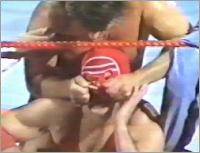 One
of the landmarks of Kendo Nagasaki's career came in September 1987, when at Bradford he defeated Wayne Bridges to
become the WWA World Heavyweight Champion. Millions of viewers sat transfixed as Nagasaki used every ounce of his
considerable experience plus copious amounts of guile and skill to claim world championship status. After a hard-
fought contest, the referee was knocked to the ground, as Wayne Bridges bent down to help the ref Nagasaki saw his
chance and grabbed Bridges the moment his guard dropped and went into a neat cross press. A count of three from the
recovering referee was all that was needed for Kendo to achieve his lifetime goal of becoming the world number one.
Naturally Wayne Bridges protested loud and vociferously, but the verdict was final: Kendo was champion of the
world. The look on George's face as the television cameras zoomed in said it all, he was euphoric. Kendo was
surrounded by an army of admirers whilst the rest of the hall looked on in disbelief, as did millions at home a few
days later.
One
of the landmarks of Kendo Nagasaki's career came in September 1987, when at Bradford he defeated Wayne Bridges to
become the WWA World Heavyweight Champion. Millions of viewers sat transfixed as Nagasaki used every ounce of his
considerable experience plus copious amounts of guile and skill to claim world championship status. After a hard-
fought contest, the referee was knocked to the ground, as Wayne Bridges bent down to help the ref Nagasaki saw his
chance and grabbed Bridges the moment his guard dropped and went into a neat cross press. A count of three from the
recovering referee was all that was needed for Kendo to achieve his lifetime goal of becoming the world number one.
Naturally Wayne Bridges protested loud and vociferously, but the verdict was final: Kendo was champion of the
world. The look on George's face as the television cameras zoomed in said it all, he was euphoric. Kendo was
surrounded by an army of admirers whilst the rest of the hall looked on in disbelief, as did millions at home a few
days later. 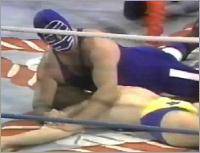
Nagasaki later teamed up with
the self proclaimed "Master of disaster" Mark Rocco for some truly sensational tag team wins - until one
unfortunate match at Croydon in 1988. The opposition on that occasion consisted of Clive Myers once again and
Yorkshire's big man Dave Taylor. As ever during a Nagasaki match, chaos reigned from the first bell. Rocco was
speed personified as he tore into the opposition, but then after ten minutes without a score Taylor slammed
Nagasaki and started to take his mask off, Rocco jumped into the ring from his tag rope to try and prevent it from
coming off. As Rocco tried to pull the mask back on, a Taylor forearm smashed him. As he fell back he pulled the
mask off revealing the by now familiar tattoo and pony tail. Nagasaki went scuttling out of the hall with his hands
over his face, Rocco stood in the ring totally speechless at what he had accidentally done. George was going
berserk at Rocco's actions, eventually Kendo returned to the ring with a black mask as George informed everyone
that he - Rocco - was now at the very top of Nagasaki's hit-list, and that the masked legend would be taking
revenge for this atrocity. It was to be the start of a feud that would last until Rocco's untimely retirement from
wrestling in 1991 following major heart surgery. Their battles would time and again involve utter contempt for the
rules and more often than not blood was shed on both sides of the ring, with Rocco taunting Nagasaki with his
prized mask, retained from the accidental unmasking.
ITV called time on their wrestling coverage after
33 years in 1988. It was a sad day indeed for British wrestling, Kendo's final appearance before the cameras was at
Bedworth where he and his new tag partner "The Rock & Roll Express" Bob Barrett took on Robbie Brookside and
Steve Regal. The bout proved even more controversial than those that had gone before, having successfully knocked
out Barrett, the Brookside/Regal combination set about Nagasaki. Brookside drop kicked Nagasaki making him groggy
for a few seconds, this was all the time the young Liverpudlian needed to untie the strings and pull off Nagasaki's
mask. Kendo got up turned around and fixed his red eyes right into Brookside's as he used his hypnotic powers to
get Brookside to turn on his partner Regal. Nagasaki quickly followed up by delivering a lethal Kamakazi Crash to
the Blackpool heavyweight, thus securing the winning fall. 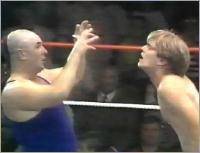 The air was thick with mystery and intrigue. Just
because ITV had deserted wrestling did not mean Kendo's career was finished - far from it. Both in solo and tag
team action Kendo continued to demolish his peers, he was simply unbeatable.
The air was thick with mystery and intrigue. Just
because ITV had deserted wrestling did not mean Kendo's career was finished - far from it. Both in solo and tag
team action Kendo continued to demolish his peers, he was simply unbeatable.
One sad event that marred
the ever growing number of wins was George Gillett's sadly declining health. During the last of the televised
contests George had looked decidedly unwell, and after 20 years in Kendo's corner, he passed away. Wrestlers and
fans alike mourned the death of one of the most colourful characters ever seen in British rings, his flamboyant
showmanship had been years ahead of its time and he was sorely missed throughout Britain. However, in the
background throughout George's illness a rock drummer called Lloyd Ryan had begun to take over Nagasaki's business
affairs.
Years before in the mid 1970's Ryan had recorded a single called "Kendo's Theme" which had
become the theme tune used whenever Nagasaki entered the ring. Lloyd took on the mantle of manager to the most
famous wrestler in the UK with relish. He taunted and sneered at Nagasaki's opponents, and took great delight in
baiting the audience. He was nearly as disliked as Nagasaki himself, whereas George had always provided wrestling
audiences with a laugh at his deliciously over-the-top ring garb... Lloyd Ryan was the complete opposite - fast-
talking London big-mouth who would continue in the grand tradition of keeping Kendo Nagasaki's name at the very
forefront of the wrestling industry. A new chapter in the long and enigmatic career of the masked man was
unfolding.

